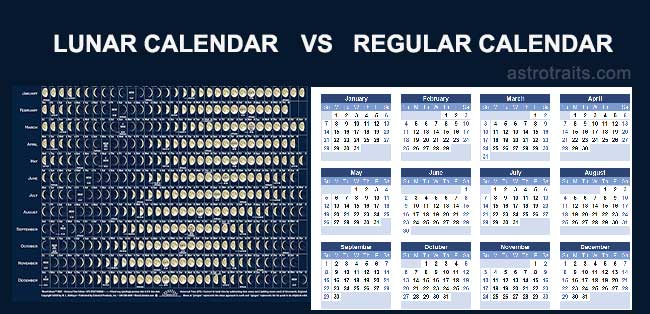
Lunar Calendar vs Regular Calendar (aka Solar Calendar, Gregorian Calendar, Western Calendar)
Every year, as January fades into February, a significant portion of the world turns its attention to the vibrant celebrations of Chinese New Year. However, the lunar festivities associated with Chinese New Year operate on a calendar system distinct from the familiar Gregorian/ Western calendar.
Let’s explore the differences between the Lunar and Gregorian calendars:
The Lunar Calendar
A lunar calendar is based on the monthly cycles of the Moon’s phases (synodic months, lunations), in contrast to “regular” calendars. Some people call Lunar Calendar -> Moon Calendar.
Each lunar cycle varies slightly from the average value. Since each lunation is approximately 29½ days, it is common for the months of a lunar calendar to alternate between 29 and 30 days.
Since the period of 12 such lunations, a lunar year, is 354 days, 8 hours, 48 minutes, 34 seconds (354.36707 days), purely lunar calendars are 11 to 12 days shorter than the solar year.
Countries and Cultures Who Use the Lunar Calendar
Several countries and cultures use the lunar calendar for religious, cultural, or traditional purposes. Some of the notable ones include:
- Islamic Calendar (Hijri or Lunar Hijri Calendar): Used by many Muslim-majority countries for Islamic religious observances and events.
- Hebrew Calendar: Used in Jewish communities around the world, often for determining the dates of religious holidays.
- Hindu Calendar: Various lunar calendars are used in Hinduism for religious purposes, though some regions also use a solar calendar.
- Islamic Calendar (Hijri or Lunar Hijri Calendar): Used by many Muslim-majority countries for Islamic religious observances and events.
- Korean Calendar: Historically, Korea used a lunar calendar for traditional holidays, though the Gregorian calendar is now the official calendar.
- Thai Lunar Calendar: Thailand historically used a lunar calendar for traditional festivals, though the Gregorian calendar is now the official calendar.
- Chinese Calendar: Used in China and several East Asian countries, particularly for traditional festivals like Chinese New Year.
Chinese Lunar Calendar:
Unlike the Gregorian calendar, which follows the solar year, Chinese New Year operates on the lunar calendar. The Chinese lunar calendar is a lunisolar calendar, incorporating both the phases of the moon and the solar year. This interplay results in a calendar system that often diverges from the Gregorian calendar, leading to variable Chinese New Year dates each year.
Chinese New Year Dates:
The date of Chinese New Year varies annually, typically falling between January 21 and February 20. This variance is due to the lunar calendar’s reliance on moon cycles, with the celebration commencing on the second new moon after the winter solstice. Each Chinese zodiac year begins on Chinese New Year, marking the transition between animal signs.
Chinese Zodiac and Its Influence:
At the heart of Chinese New Year is the Chinese zodiac, a twelve-year cycle each associated with an animal sign. Understanding your zodiac sign and the characteristics associated with it is a crucial aspect of the celebrations. From the energetic Rat to the wise Ox and the charismatic Dragon, each zodiac sign brings its unique flavor to the festivities.
Lunar Traditions and Global Celebrations:
Chinese New Year is a time of family reunions, feasting, and vibrant festivities. Traditional customs, such as the lion and dragon dances, firecrackers, and the exchange of red envelopes (hongbao), add to the festive spirit. While these traditions have ancient roots, they continue to captivate audiences worldwide, transcending cultural boundaries.
Calendar Convergence: Chinese New Year in the Gregorian World:
In our modern, interconnected world, the Gregorian calendar holds sway in most aspects of life. However, the global recognition and celebration of Chinese New Year showcase the harmonious coexistence of lunar traditions within the broader framework of the Gregorian calendar. This convergence emphasizes the cultural significance and universal appeal of the Lunar New Year.
Gregorian Calendar aka Solar Calendar aka Western Calendar aka the Christian Calendar aka “Regular” Calendar aka “Standard” Calendar
The Gregorian calendar is also known as the Western calendar or Christian calendar, reflecting its historical and cultural associations with Western Christianity. Its wide adoption is due to its accuracy in tracking the solar year, making it a standard for international business, administration, and civil affairs.
The Gregorian calendar is a solar calendar based on the Earth’s orbit around the Sun, and it comprises 12 months, each with fixed lengths. The calendar year consists of approximately 365.2422 days, with leap years introduced to account for the extra 0.2422 days.
A solar calendar is a calendar whose dates indicate the season or almost equivalently the apparent position of the Sun relative to the stars. The Gregorian calendar, widely accepted as a standard in the world, is an example of a solar calendar.
The Gregorian calendar, introduced by Pope Gregory XIII in October 1582, is the calendar system widely used today for international purposes. It replaced the Julian calendar and aimed to align the timing of the spring equinox with the date of March 21.